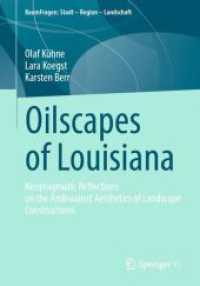- ホーム
- > 洋書
- > ドイツ書
- > Humanities, Arts & Music
- > History
- > antiquity
Description
(Text)
In this volume the Byzantine provinces of Bithynia and Hellespont are treated. They comprise the whole northwest of Asia Minor. The region is especially important because of its position across from the capital of the Byzantine Empire. The shores opposite Constantinople were considered its suburbs, where the emperors and the aristocracy built their palaces and villas and founded many monasteries and churches. Products of agriculture from Bithynia, to a lesser part also from Hellespont, contributed considerably to the provision of the capital with food.The close relations between Bithynia and Hellespont with Constantinople result in a great number of written sources that mention many settlements in the area under consideration. The present volume aims to draw a picture of the region from the point of view of the Historical Geography. For this purpose, written sources are used as well as travel reports from the Early Modern Period onwards, archaeological documentation and observations of the author in the country. In the introductory chapters, the borders of the area, its geography, history, church history, lines of communication and economic conditions are treated by way of an overview. In the main part, the history and/or the archaeological remains of all Byzantine settlements, fortresses, churches and monasteries as well as of mountains and rivers are presented in an alphabetical catalogue. A choice of characteristic landscapes and of ruins and other remains are shown on photographical tables. Added to the volume is a map (scale 1 : 800.000) that shows not only the area comprised in this volume but also the region north of the Sea of Marmara (treated as Ostthrakien by A. Külzer, volume 12 of the TIB), so that the entire "Region of the the Sea of Marmara" with its centre Constantinople is displayed. Densely inhabited areas are also shown on three maps with larger scales.
(Author portrait)
Klaus Belke, geboren 1947 in Freiburg im Breisgau (Deutschland). Nach dem Studium der Byzantinistik, der Klassischen Philologie und der Arabistik sowie der Promotion in Byzantinistik Mitarbeiter an der Kommission für die Tabula Imperii Byzantini (jetzt Abteilung Byzanzforschung des Instituts für Mittelalterforschung) der Österreichischen Akademie der Wissenschaften. 1999 Habilitation für das Fach Byzantinistik mit dem Band Paphlagonien und Hon rias (TIB 9). Seit der altersbedingten Pensionierung 2012 arbeitet er ehrenamtlich an der Abteilung Byzanzforschung zu Projekten der Historischen Geographie. Forschungsschwerpunkte sind Historische Geographie des Byzantinischen Reiches, römische und byzantinische Straßen, Verkehrsmittel zu Lande, Portulane und Portulankarten.Belke, KlausKlaus Belke, geboren 1947 in Freiburg im Breisgau (Deutschland). Nach dem Studium der Byzantinistik, der Klassischen Philologie und der Arabistik sowie der Promotion in Byzantinistik Mitarbeiter an der Kommission für die Tabula Imperii Byzantini (jetzt Abteilung Byzanzforschung des Instituts für Mittelalterforschung) der Österreichischen Akademie der Wissenschaften. 1999 Habilitation für das Fach Byzantinistik mit dem Band Paphlagonien und Hon rias (TIB 9). Seit der altersbedingten Pensionierung 2012 arbeitet er ehrenamtlich an der Abteilung Byzanzforschung zu Projekten der Historischen Geographie. Forschungsschwerpunkte sind Historische Geographie des Byzantinischen Reiches, römische und byzantinische Straßen, Verkehrsmittel zu Lande, Portulane und Portulankarten.








